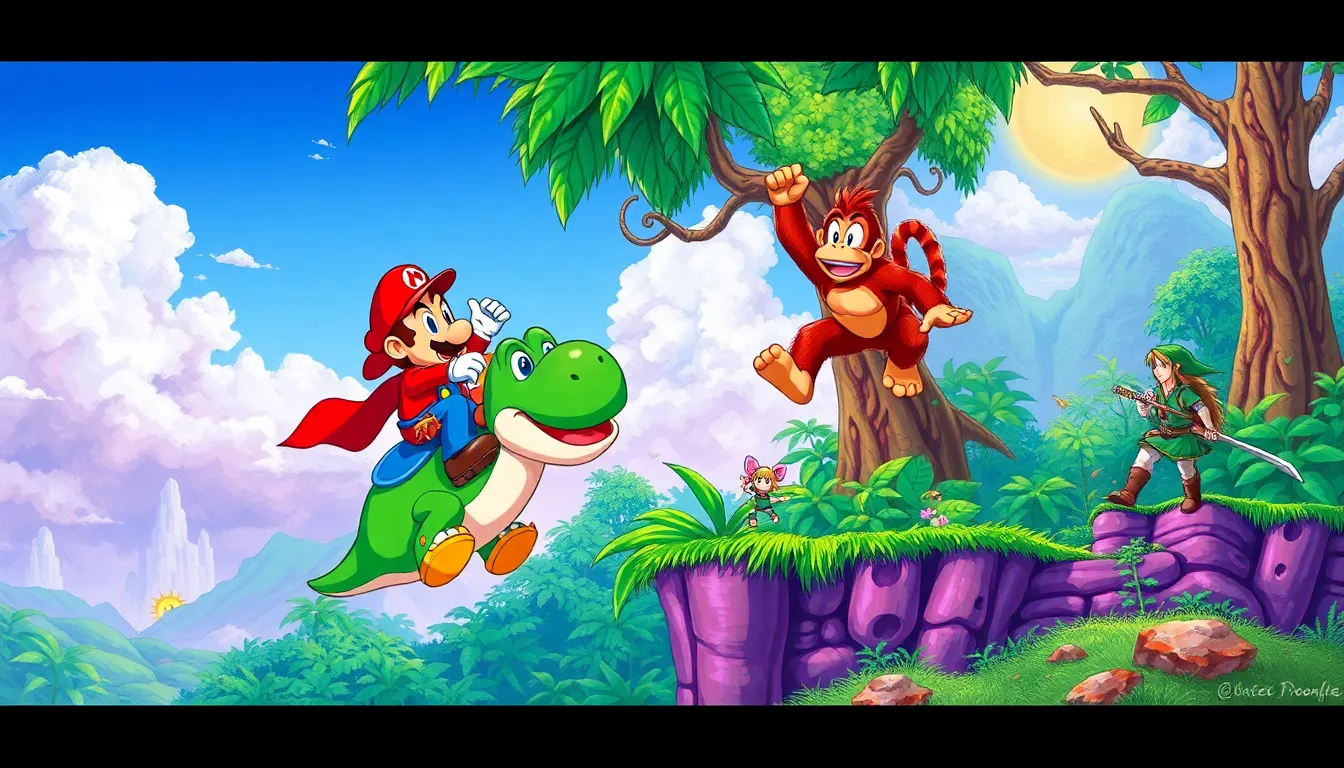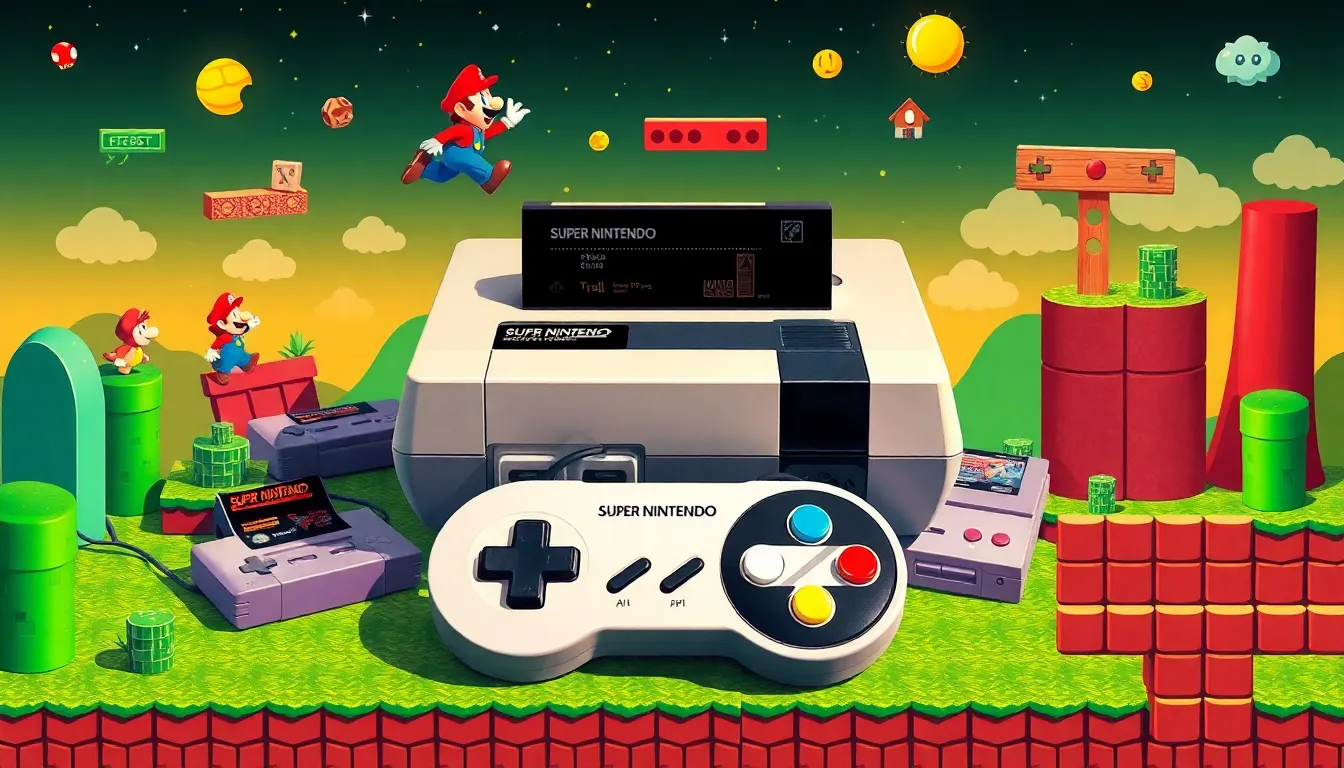In the magical realm of gaming, few consoles can boast a legacy as legendary as the Super Nintendo Entertainment System. Among its many treasures, SNES platformers stand out like a golden mushroom in a field of ordinary toadstools. These pixelated adventures not only defined a generation but also set the stage for countless gaming innovations. Who could forget the thrill of jumping on a Goomba or collecting shiny coins while racing against time?
With their vibrant graphics and catchy soundtracks, SNES platformers captured hearts and provided endless hours of entertainment. Whether you were a seasoned gamer or just a curious kid, these games offered a delightful escape into fantastical worlds. So buckle up and get ready to dive into the whimsical universe of SNES platformers, where every jump and power-up brings a smile and a dash of nostalgia.
SNES Platformers
SNES platformers represent a unique genre that defined the gaming landscape in the 1990s. They showcase innovative gameplay mechanics and captivating storytelling.
Definition and Characteristics
Platformers on the SNES involve navigating characters through diverse environments. Players control characters who jump between platforms, avoid obstacles, and collect items. Level design features vibrant graphics and clever enemy placements that challenge players’ skills. Each game often includes power-ups that enhance gameplay, offering unique abilities or extra lives. The combination of engaging music and colorful visuals contributes to a compelling gaming experience.
Historical Context
The SNES emerged in 1990, establishing a significant presence in home gaming. Titles released during the console’s lifespan featured advanced technology, enhancing gameplay compared to previous systems. Popular titles like “Super Mario World” and “Donkey Kong Country” set benchmarks for platform games. The genre gained popularity and recognition, influencing future game design across platforms. Both player demographics and gaming culture evolved alongside these beloved titles, solidifying their legacy in history.
Popular SNES Platformers

Several platformers emerged on the SNES, showcasing unique gameplay and captivating stories. These titles enjoyed widespread acclaim and remain influential in gaming history.
Super Mario World
Super Mario World revolutionized platform gaming, introducing Yoshi, a beloved companion. Players traversed the colorful Mushroom Kingdom, completing levels filled with secrets and power-ups. This game featured innovative mechanics, such as the cape feather, enabling players to fly and access new areas. Over 26 million copies sold solidified its status as a best-seller. With its charming graphics and catchy soundtrack, Super Mario World defined the SNES experience and inspired future platformers. Players experienced engaging level designs, creating a blueprint for the genre.
Donkey Kong Country
Donkey Kong Country showcased groundbreaking graphics through pre-rendered 3D visuals, setting a new standard for the era. Players navigated lush environments, overcome obstacles, and faced creative enemies. Its engaging co-op gameplay allowed friends to team up, enhancing the fun factor. Featuring memorable characters like Donkey and Diddy Kong, this title captivated audiences with vibrant settings and challenging levels. The game sold over 9 million copies, demonstrating widespread popularity. Additionally, the iconic soundtrack contributed to an immersive experience, making Donkey Kong Country a pivotal title within the platforming genre.
The Legend of Zelda: A Link to the Past
The Legend of Zelda: A Link to the Past merged action and adventure with platforming elements, creating a unique experience. Players explored the vast land of Hyrule, solving puzzles and battling various foes. Featuring a top-down perspective, this game introduced innovative mechanics like the ability to switch between the Light and Dark worlds. Robust storytelling and rich character development drew players into its captivating narrative. The game sold over 4 million copies and is often regarded as one of the greatest video games of all time. Challenging dungeons, memorable items, and intricate level designs made it a cornerstone of the SNES platforming experience.
Gameplay Mechanics in SNES Platformers
SNES platformers feature innovative gameplay mechanics that enhance player engagement and enjoyment. Two core aspects include level design and power-ups.
Level Design
Level design in SNES platformers showcases creativity and diversity. Each game presents unique environments that challenge players. “Super Mario World” introduced intricate levels with secret pathways, enhancing exploration. “Donkey Kong Country” featured varied settings, incorporating verticality and unique hazards. These design choices created a dynamic gameplay experience. Engaging level layouts encouraged players to master their skills. Obstacles and enemy placements often required strategic thinking, promoting problem-solving. Player navigation through diverse terrains added excitement. Additionally, many levels utilized thematic elements, further immersing players in the world.
Power-Ups and Collectibles
Power-ups and collectibles play pivotal roles in SNES platformers. These elements often enhance gameplay and provide strategic advantages. “Super Mario World” introduced iconic power-ups like the Super Mushroom and Fire Flower, transforming gameplay dynamics. Collecting coins and Yoshi tokens encouraged exploration, rewarding players for thoroughness. Character abilities evolved with power-ups, offering unique experiences. In “Donkey Kong Country,” players could collect bananas for bonus lives and unlock secrets, promoting engagement. Various collectibles across different titles fostered a sense of accomplishment. Overall, power-ups and collectibles enriched the gaming experience, motivating players to explore each level’s intricacies.
Impact of SNES Platformers on Gaming
SNES platformers played a crucial role in shaping the future of video games. These titles set high standards for graphics, level design, and gameplay mechanics that many developers still follow today.
Influence on Future Titles
Innovative mechanics in SNES platformers inspired countless future titles. For instance, “Super Mario World’s” introduction of Yoshi influenced character design in later games, fostering creative gameplay elements. Titles like “Celeste” and “Hollow Knight” demonstrate the lasting influence of these classics, showcasing vibrant graphics and intricate level design. Additionally, the cooperative gameplay seen in “Donkey Kong Country” paved the way for multiplayer experiences in contemporary platformers. Game developers often cite SNES games as foundational influences in their design philosophy, ensuring the legacy continues in modern gaming.
Legacy in the Gaming Community
The gaming community cherishes SNES platformers as milestones in gaming history. Major conventions often celebrate these classics, where fans gather to reminisce and share experiences. Social media platforms are filled with discussions and fan art inspired by titles like “The Legend of Zelda: A Link to the Past,” reflecting their enduring popularity. Nostalgia plays a significant role in this legacy, as more players discover these gems through re-releases and virtual consoles. Events celebrating the 30th anniversary of the SNES further highlight the impact these games had on shaping the gaming culture.
Conclusion
The legacy of SNES platformers continues to resonate with gamers of all ages. Their innovative gameplay and captivating stories have left an indelible mark on the gaming industry. As players revisit these classics, they not only experience nostalgia but also appreciate the creativity and artistry that defined a generation.
These titles paved the way for future developments in game design, ensuring their influence remains strong today. The vibrant worlds and memorable characters of SNES platformers captivate new audiences while celebrating the rich history of video gaming. Embracing both past and present, the charm of these games endures, inviting everyone to embark on adventures that shaped the landscape of gaming culture.

